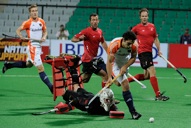Unit Overview


Rationale:
The objective with our field hockey unit, and physical education in general, is to have students develop appropriate knowledge, skills, and attitudes through participating actively, effectively, safely, and responsibly in a range of activities. (Ministry Of BC, 2008) These objectives are important because they play a huge role in determining how active students are in their lives after high school. However, along with the objectives from the BC IRP students must also gain the ability, confidence and desire to be physically active through a variety of activities later in life. As educators we have a responsibility to do more than just teach the knowledge, skills and attitudes based on sports and games, we must engage the students. Educators can increase engagement through critical thinking and facilitate learning that will encourage students to discover their abilities and encourage them to continue to be active and further develop their skills. In order to increase student engagement in games our lesson focuses on using a teaching games for understanding (TGfU) approach first introduced by R. Thorpe and D. Bunker. TGfU is a learner centred model that fosters the development of student’s abilities via a game centred approach to enhance game performance, cognitive responses, and skill development in a positive environment. (Mitchell & Oslin, 1999) TGfU strives to develop students’ abilities via creating an inclusive environment by modification in representation and modification with exaggeration of games. Modification in representation creates mini games that contain the same tactical problems as adult games but adapts the game to the learner’s size, age, and ability. Modifications with exaggeration focuses on tactical problems that may be too difficult to solve in mini games so secondary rules are used to exaggerate tactical problems. Both of these modifications create inclusive environments that adapt games to student’s abilities to give them success and hopefully engage them in the activity. Within specific drills and tasks modifications can also be made to meet the needs of each students individual abilities such that more advanced learners have more of a challenge well less developed players still have a chance for success. Adaptations can be made to space, time, equipment, and players (“STEP”). For each basic task within our unit it is our goal to use the basic task model in order to help improve students skills and cognitive abilities by refining tasks with extensions ( or simplifications if needed) in order to apply to basic task learned.
With specificity to our field hockey unit, we have integrated this approach into each lesson to try to engage the students. Field hockey falls into the territorial game category which allows for many of the skills and concepts taught within our game-based approach lessons to be transferred over to other territorial games. Tactical concepts that can transfer over include on and off ball decision making, supporting, marking/guarding, covering, adjusting, and base positioning.



